July 18, 2024
Climate Change Poster Collection of the Day – Alpine Ecosystems
Book a Demo
Today’s Climate Change Poster Collection highlights Alpine ecosystems, characterized by their high-altitude environments and unique biodiversity, are among the most sensitive regions to climate change, and the changes occurring within these ecosystems offer a compelling illustration of the broader impacts of global warming. These ecosystems, found in mountain ranges worldwide from the Rockies in North America to the Himalayas in Asia and the Andes in South America, are experiencing profound transformations due to rising global temperatures. The delicate balance of life in these regions is intricately linked to specific climatic conditions, including cold temperatures, consistent snow cover, and short growing seasons. As global temperatures rise, these conditions are being disrupted, leading to a cascade of ecological consequences that threaten the very fabric of alpine life.
One of the most visible signs of climate change in alpine regions is the retreat of glaciers and reduction in snow cover. Glaciers, which have taken millennia to form, are melting at unprecedented rates, contributing to rising sea levels and altering freshwater availability for millions of people downstream. This loss of ice not only affects water supply but also impacts the albedo effect, where the reflective ice surfaces are replaced by darker land or water, absorbing more heat and accelerating warming. This phenomenon creates a feedback loop that exacerbates the rate of glacial melt and temperature rise. The disappearance of glaciers also leads to the formation of glacial lakes, which pose risks of outburst floods that can devastate downstream communities and ecosystems.
The flora and fauna of alpine ecosystems are also under significant threat. Many species have adapted to the harsh conditions of high altitudes, and even slight changes in temperature can push them beyond their tolerance limits. For instance, alpine plants, which are adapted to cold, nutrient-poor soils, may find it difficult to compete with encroaching lower-altitude species as temperatures rise. This shift in vegetation zones can lead to the loss of specialized alpine plants, some of which are endemic and found nowhere else on Earth. Similarly, animals such as the snow leopard, the mountain pika, and various alpine birds, which rely on specific habitats, are facing habitat loss and fragmentation. The snow leopard, for example, is already endangered, and the shrinking of its cold, mountainous habitat further threatens its survival.
Furthermore, the phenology, or the timing of biological events, is being altered. Plants are blooming earlier, and the life cycles of insects and other animals are shifting, leading to mismatches in food availability and reproductive cycles. This disruption in synchrony can have far-reaching impacts on the entire ecosystem. For example, if alpine flowers bloom earlier than usual due to warmer temperatures, but pollinators like bees and butterflies do not adjust their life cycles accordingly, it can result in reduced pollination success and subsequent declines in plant populations. These changes can ripple through the food web, affecting herbivores and predators alike.
Alpine ecosystems also play a crucial role in water regulation, acting as natural reservoirs that release water gradually throughout the year. With the reduction in snowpack and glaciers, the timing and quantity of water flow are being altered, affecting agriculture, hydroelectric power, and drinking water supplies far beyond the mountains. Many rivers that originate in alpine regions, such as the Ganges, Yangtze, and Colorado, are lifelines for vast populations. Changes in their flow patterns can lead to water shortages during critical growing seasons, impacting food security and livelihoods.
The cultural and recreational value of alpine regions cannot be overlooked either. Many communities depend on these ecosystems for their livelihoods through tourism, skiing, and mountaineering. As the landscape changes, these economic activities are also at risk. Ski resorts, for example, are facing shorter seasons and less reliable snow cover, which can lead to economic losses and job insecurity for those who depend on winter tourism. Additionally, the aesthetic and spiritual values that mountains hold for many cultures are being eroded as iconic landscapes transform.
Addressing the impacts of climate change on alpine ecosystems requires a multifaceted approach. Conservation efforts must prioritize the protection of critical habitats and the restoration of degraded areas. Sustainable tourism practices should be implemented to minimize environmental impact and support local economies. Additionally, global climate action to reduce greenhouse gas emissions is essential to mitigate the root causes of climate change. International cooperation and policy measures are needed to support adaptation strategies for communities and ecosystems alike.
Protecting these fragile environments is not only crucial for the biodiversity they harbor but also for the countless human lives that depend on the services they provide. The story of alpine ecosystems and climate change is a microcosm of the broader environmental challenges we face. It underscores the urgent need for comprehensive, coordinated action to preserve the natural world and ensure a sustainable future for all.
Discover an inspiring collection of climate change poster.



